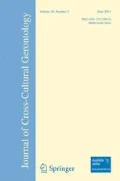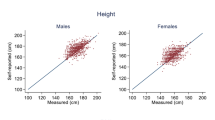Abstract
Body weight has important health implications across the lifespan. Most recent attention has focused on the obesity epidemic that is occurring in many parts of the world. However, underweight is also a concern, particularly in less developed countries. For most health outcomes there is a curvilinear association with body weight, with underweight and overweight (compared to normal weight) being associated with a higher prevalence of chronic debilitating and life-threatening conditions and ultimately mortality. This paper uses data from two nationally-representative surveys of older adults (aged 60 and older) in the Philippines (1996) and Taiwan (1999) to assess the prevalence of underweight and overweight and examine associations between body weight and demographic, socioeconomic, and health characteristics in these populations. Older Filipinos have a modest prevalence of underweight (29.9%) and low prevalence of overweight (12.2%), whereas the reverse is observed in Taiwan (6.4 and 29.3%, respectively). Results show generally expected associations between body weight and demographic characteristics, health conditions and behaviors. We find little evidence of socioeconomic differences in body weight, except in the Philippines where higher SES is associated with a lower risk of being underweight. Implications of the results are discussed in terms of healthy weight maintenance among critical subgroups to potentially reduce the prevalence of disease and improve quality of life.
Similar content being viewed by others
References
Barbara, C., Cavalli-Sforza, T., Cutter, J., Darnton-Hill, I., et al. (2004). Appropriate body mass index for Asian populations and its implications for policy and intervention strategies. The Lancet, 363(9403), 157–166.
Black, D. R., Taylor, A. M., & Coster, D. C. (1998). Stepped Approach Model (SAM) component assessment: Accuracy of self-reported body weight. Health Education Research: Theory and Practice, 13, 301–307.
Chatterjee, P. (2002). India sees parallel rise in malnutrition and obesity. The Lancet, 360, 1948.
Farrales, L., & Chapmann, G. (1999). Filipino women living in Canada: Constructing meanings of body, food, and health. Health Care of Women International, 20(2), 179–194.
Ferraro, K. F., & Booth, T. L. (1999). Age, body mass index, and functional illness. Journal of Gerontology: Social Sciences, 54B, S339–S348.
Fonda, S. J., Fultz, N. A., Jenkins, K. R., Wheeler, L., & Wray, L. A. (2004). The relationship of body mass and net worth for retirement—Aged men and women. Research on Aging, 26(1), 153–176.
Galanos, A., Pieper, C., Cornoni-Huntley, J., Bales, C., & Fillenbaum, G. (1994). Nutrition and Function: Is there a relationship between body mass index and functional capacity of community dwelling elderly? Journal of the American Geriatrics Society, 42, 368–373.
Griffiths, P., & Bentley, M. (2001). The nutrition transition is underway in India. The Journal of Nutrition, 1331(10), 2692–2697.
Gu, D., Reynolds, K., Wu, X., Chen, J., Duan, X., Muntner, P., et al. (2002). Prevalence, awareness, treatment, and control of hypertension in China. Hypertension, 40(6), 920–927.
Hanh, T. T. M., Komatsu, T., Hung, N. T., Chuyen, V. N., Yoshimura, Y., Tein, P. G., et al. (2001). Nutritional status of middle-aged Vietnamese in Ho Chi Minh City. Journal of the American College of Nutrition, 20(6), 612–616.
Hermalin, A. I. (2002). Capturing change: Transitions at older ages and cohort succession. In A. I. Hermalin (Ed.), Chapter 12, The well-being of the elderly in Asia: A four-country comparative study (pp. 519–541). Ann Arbor, MI: The University of Michigan Press.
Hill, J. O., Wyatt, H. R., Reed, G. W., & Peters. J. (2003). Obesity and the environment: Where do we go from here? Science, 299, 853–855.
Himes, C. L. (2000). Obesity, disease, and functional limitation in later life. Demography, 37(1), 73–82.
Holdsworth, M., Gartner, A., Landais, E., & Delpeuch, F. (2004). Perceptions of healthy and desirable body size in urban Senegalese women. International Journal of Obesity and Related Metabolic Disorders, 28(12), 1561–1568.
Jenkins, K. R. (2004). Obesity’s effects on the onset of functional impairment among older adults. The Gerontologist, 44(2), 206–216.
Jousilahti, P., Vartiainen, E., Tuomilehto, J., & Puska, P. (1999). Sex, age, cardiovascular risk factors, and coronary heart disease. Circulation, 99(9), 1165–1678.
Kuhnlein, H., Receveur, O., Soueida, R., & Egeland, G. (2004). Artic indigenous peoples experience the nutrition transition with changing dietary patterns and obesity. Journal of Nutrition, 134, 1447–1453.
Lee, S., Leung, T., Lee, A. M., Yu, H., & Leung, C. M. (1996). Body dissatisfaction among Chinese undergraduates and its implications for eating disorders in Hong Kong. International Journal of Eating Disorders, 20(1), 77–84.
Marton, K. I., Sox, H. C., & Krupp, J. R. (1981). Involuntary weight loss: Diagnostic and prognostic significance. Annals of Internal Medicine, 95, 568–574.
McIntosh, W. A., & Sobal, J. (2004). Rural eating, diet, nutrition, and body weight. In N. Glasgow, L. W. Morton, & N. E. Johnson (Eds.), Chapter 10, Critical issues in rural health (pp. 113–124). Ames, IA: Blackwell.
Mendez, M., Monteiro, C., & Popkin, B. (2005). Overweight exceeds underweight among women in most developing countries. American Journal of Clinical Nutrition, 81(3), 714–721.
Meyer, P. A., Mannino, D. M., Redd, S. C., & Olson, D. R. (2002). Characteristics of adults dying with COPD. Chest, 122, 2003–2008.
Monteiro, C., Moura, E., Conde, W., & Popkin, B. (2004). Socioeconomic status and obesity in adult populations of developing countries: A review. Bulletin of the World Health Organization, 82(12), ISSN 0042-9686.
Morton, L. W., Worthen, H. D. I., & Weatherspoon, L. J. (2004). Rural food insecurity and health. In N. Glasgow, L. W. Morton, & N. E. Johnson (Eds.), Chapter 9, Critical issues in rural health (pp. 101–112). Ames, IA: Blackwell.
Must, A., Spadano, J., Cokley, E., Field, A., Colditz, G., & Dietz, W. (1999). The Disease burden associated with overweight and obesity. Journal of the American Medical Association, 282(16), 1523–1529.
National Heart, Lung, and Blood Institute. (1998). Clinical guidelines on the identification, evaluation, and treatment of overweight and obesity in adults: The evidence report (NIH Publication No. 98-4083). Bethesda, MD.
Popkin, B. M. (1993). Nutritional patterns and transitions. Population and Development Review, 19(1), 138–157.
Popkin, B. (2004). The nutrition transition: An overview of world patterns of change. Nutrition Reviews, 62(7), S140–S143.
Popkin, B., & Gordon-Larsen, P. (2004). The nutrition transition: World wide obesity dynamics and their determinants. International Journal of Obesity, 28, S2–S9.
Raghunathan, T., Lepkowski, J., Van Hoewyk, J., & Solenberger, P. (1998). A multivariate technique for multiply imputing missing values using a sequence of regression models. Survey Research Center, The University of Michigan.
Raghunathan, T., Solenberger, P., & Van Hoewyk, J. (2000). IVEware: Imputation and variance estimation software installation instructions and user guide. The University of Michigan.
Republic of China. (1998). Statistical Yearbook of the republic of China. Republic of China: Directorate-General of Budget, Accounting and Statisitcs, Executive Yuan.
Seidell, J. C., Verschuren, W. M., van Leer, E. M., & Kromhout, D. (1996). Overweight, underweight, and mortality. A prospective study of 48,287 men and women. Archives of Internal Medicine, 156(9), 958–963.
Shih, M., & Kubo, C. (2005). Body shape preference and body satisfaction of Taiwanese and Japanese female college students. Psychiatry Research, 133, 263–271.
Smil, V. (2002). Eating meat: Evolution, patterns, and consequences. Population and Development Review, 28(4), 599–639.
Stunkard, A., & Albaum, J. (1981). The accuracy of self-reported weights. The American Journal of Clinical Nutrition, 34, 1593–1599.
Troy, L., Hunter, D., Manson, J., Colditz, G., Stampfer, M., & Willett, W. (1995). The validity of recalled weight among younger women. International Journal of Obesity, 19, 570–572.
Woo, J., Ho, S. C., Yu, A. L. M., & Sham, A. (2002). Is waist circumference a useful measure in predicting health outcomes in the elderly? International Journal of Obesity, 26(10), 1349–1355.
World Bank. (1997). World development report 1997. New York: Oxford University Press.
Yang, C., Gray, P., & Pope, H. (2005). Male body image in Taiwan verses the west: Yanggang Zhiqi meets the Adonis complex. American Journal of Psychiatry, 162(2) 263–269.
Yuan, J. M., Ross, R. K., Gao, Y. T., & Yu, M. C. (1998). Body weight and mortality: A prospective evaluation in a cohort of middle-aged men in Shangai, China. International Journal of Epidemiology, 27(5), 824–832.
Acknowledgements
Partial support for this project was provided by a post-doctoral research fellowship (Grant: 5 T32 AG00221) and by a research project (R01 AG020072-03) funded from the National Institute on Aging. We thank Yi-Li Chuang and staff in the Center for Population and Health at the Bureau of Health Promotion in Taiwan for conducting the Taiwan panel study and making the data available for analysis and Josefina Natividad and the Population Institute at the University of the Philippines for conducting the Philippine study and making the data available. An earlier version of this manuscript was presented at the 2003 Gerontological Society of America Annual Meetings in San Diego, CA.
Author information
Authors and Affiliations
Corresponding author
Rights and permissions
About this article
Cite this article
Jenkins, K.R., Johnson, N.E. & Ofstedal, M.B. Patterns and Associations of Body Weight Among Older Adults in Two Asian Societies. J Cross Cult Gerontol 22, 83–99 (2007). https://doi.org/10.1007/s10823-006-9031-1
Published:
Issue Date:
DOI: https://doi.org/10.1007/s10823-006-9031-1




